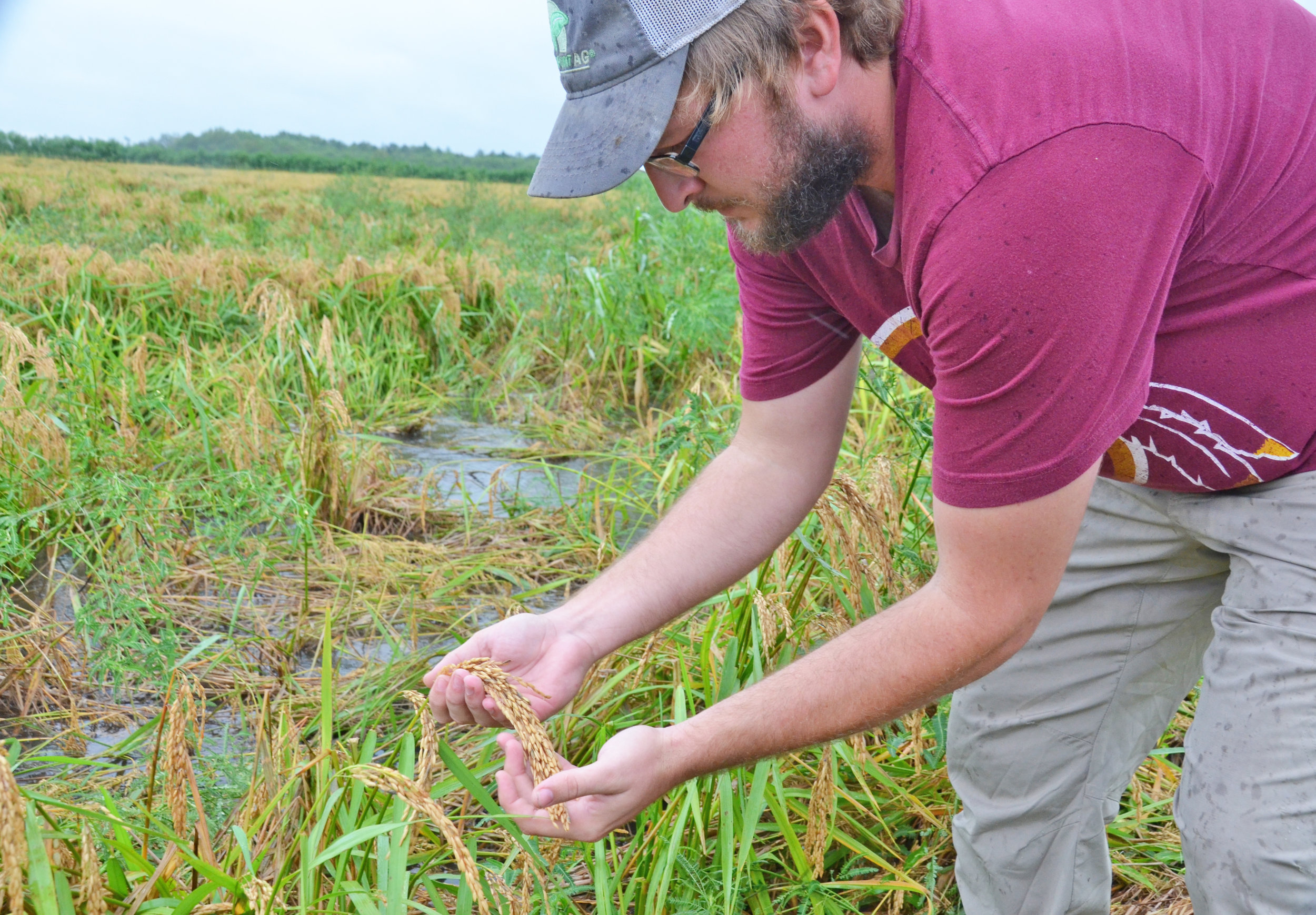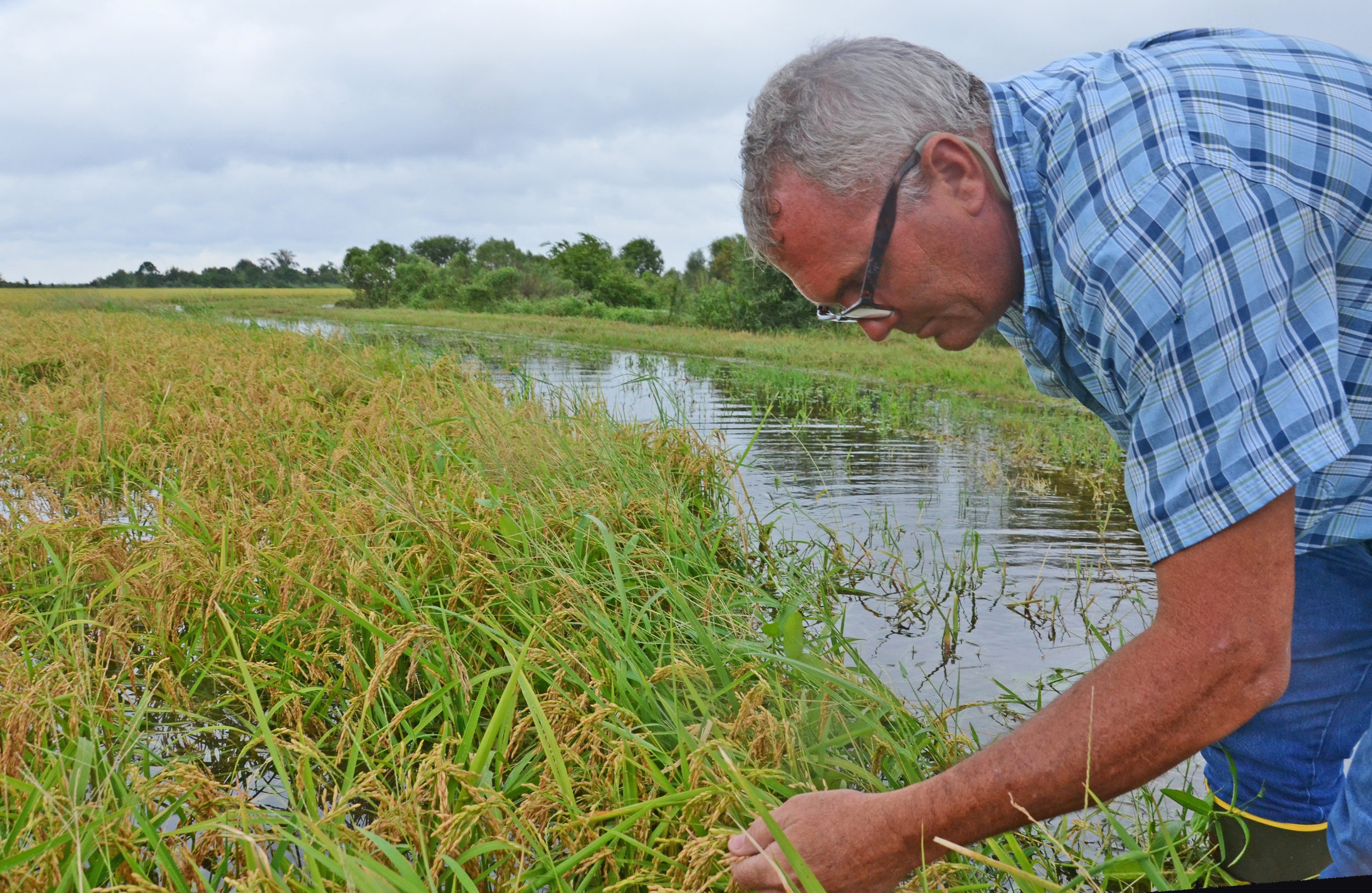Harvey Creates Problems for Louisiana Farmers
By Bruce Schultz, LSU AgCenter
Farmer Josh Sikes holds a soybean plant in his field near Vinton, Louisiana. Sikes has 1,200 acres of soybeans, but not all of it flooded from Tropical Storm Harvey. Photo by Bruce Schultz/LSU AgCenter
VINTON — Farmers Adam Habetz and Josh Sikes were getting their first look at their crops on Aug. 30 just after Tropical Storm Harvey had passed over western Calcasieu Parish.
“I was not expecting this,” Sikes said as he looked over about 80 acres of flooded soybeans. “I’m going to lose a lot of beans.”
But a larger area of his soybeans on higher ground appeared to have been spared from high water.
Farmer Josh Sikes, of Vinton, Louisiana, gets his first look at his rice. He has 600 acres yet to be harvested, and much of it has started sprouting as a result of rain from Tropical Storm Harvey. Photo by Bruce Schultz/LSU AgCenter
Rice that should have been harvested was already sprouting in Sikes’ and Habetz’s fields, not from flooding but from being continuously wet with constant rainfall.
Near the Texas-Louisiana line, Habetz has about 115 acres left to harvest after harvesting 125 acres, and Sikes said he still had 600 acres remaining after harvesting 250 acres.
LSU AgCenter extension rice specialist Dustin Harrell said sprouted rice can still be sold and milled, although farmers will get less money for damaged grain. If the grain is broken, it can be used for pet food.
Farmer Fred Habetz, of Vinton, Louisiana, examines his rice crop near the Louisiana-Texas line. Some of the rice had begun to sprout in this field but fields that were not as mature had not started showing signs of sprouting as a result of rain from Tropical Storm Harvey. Photo by Bruce Schultz/LSU AgCenter
A phone survey revealed that about 10,000 acres of first-crop rice remains left for harvest in south Louisiana, he said. The state has almost 400,000 acres of rice this year.
The biggest losses appear to be in Calcasieu, Cameron, Vermilion and Jefferson Davis parishes.
“The big unknown at the moment is the ratoon rice in that area,” Harrell said. “Ratoon rice is very important economically, and it, too, can be lost if the ratoon stubble remains submerged for several days.”
That’s what farmer Paul Johnson tried to prevent Wednesday. He was in a boat and used hay bales to plug levee breaks that were flooding his ratoon crop. “That seems to be holding right now. I don’t think it’s coming up anymore,” he said of the water level in the field.
Johnson’s farm near Bell City got 17 inches of rain from Thursday to Wednesday, and most of it fell Tuesday. But he said he’s keeping an eye on two potential threats: a storm brewing in the Atlantic and an area of disturbed weather in the Bay of Campeche.
The north Louisiana harvest was shaping up to be a bumper crop before Harvey, Harrell said.
Farmer Adam Habetz examines panicles of rice from his farm near Vinton, Louisiana. The rice was starting to sprout after being wet, but not flooded, from heavy rainfall brought by Tropical Storm Harvey. Photo by Bruce Schultz/LSU AgCenter
Keith Collins, LSU AgCenter extension agent in Richland Parish, said it’s too early to know if the storm hurt north Louisiana rice. He said winds were about 25 miles an hour, and rain has not been excessive.
“Hopefully in next two to three days with sunshine predicted, we will dry out enough for folks to get out and assess damage,” Collins said.
The cotton crop in north Louisiana is close to harvest, and about 20 percent of the corn remains to be harvested. AgCenter cotton and corn specialist Dan Fromme said he’s not heard of any damage to either crop from Harvey.
“It’s still a little early to tell,” he said. “We’ll know more next week.”
No crop flooding from Harvey has been reported in north Louisiana.
Sikes still was concerned about what Harvey could do to his 3,000 acres of cotton in Tensas Parish.
Handful of sprouted rice. Photo by Bruce Schultz/LSU AgCenter
“I was ready to defoliate before this,” Sikes said. “If Harvey will get on out of here, I don’t think we will see much more of a yield loss than what we were predicting we were already going to lose from all the previous bad weather cycles recently.”
Habetz checked a field of second-crop rice that wasn’t completely covered by high water. Muddy conditions for the first crop harvest resulted in rutted fields that have left large gaps in the rice.
Habetz also is concerned about hay for his cattle. Pastures have been too wet to harvest hay throughout the summer, and field conditions have been too wet to bale rice straw.
“It’s been so wet all summer,” he said. “Nobody’s got any hay.”
Habetz’s cousin, Fred Habetz, said his rice just a few miles from the Texas state line had gotten 12 inches of rain since the downpours started Thursday, Aug. 24.
Most of Fred Habetz’s fields hadn’t fully matured, so his rice had not started sprouting. But he was worried that his fields might flood again from the opening of the dam at Toledo Bend just like they flooded in spring 2016.
Fred Habetz said he had to replant his rice this year because ducks ate his seed.
Craig Zaunbrecher, of Welsh, said he had 300 acres of rice that flooded. He had to replant that field because of flooding in the spring.
“We’re very concerned about it,” he said. “Looks like we’re going to lose it twice.”
Problems aren’t limited to rice and soybeans, however.
Andrew Granger, LSU AgCenter extension agent in Vermilion Parish, said westerly winds Wednesday afternoon started blowing sugarcane down as Harvey moved inland.
“Tall cane and muddy ground are not a good combination,” Granger said.
Granger said the cane will continue growing, but it will start curving, and that makes planting whole stalks of cane difficult. Farmers may have to use cut pieces of stalk, called billets, for planting.
Lodged cane also can affect yields, Granger said. “That remains to be seen.”
Many cattle owners had moved their herds to higher ground, but they may wait until after the hurricane threat has passed to relocate them, Granger said.
Jimmy Meaux, LSU AgCenter extension agent in Calcasieu Parish, said water is continuing to rise in some areas, particularly near Creole. Some cattle herds there are in standing water up to 36 inches deep.
Water in the east side of the parish is likely to recede before the west side, where more flooding from the Toledo Bend release is likely, he said.
Kevin Savoie, LSU AgCenter and Sea Grant extension agent in Cameron Parish, said floodwater from the north will have to pass through Cameron Parish, and that will cause high water to remain in the area.
“We’re trying to get back to normal,” Savoie said. The storm surge only amounted to 1-2 feet of water, and heavy rains caused most flooding.
“We’ve got a bad mosquito problem on the way,” he said. Spraying operations for the insects have been stalled because of stormy weather, giving mosquitoes a head start.
Bradley Pousson, LSU AgCenter extension agent in Cameron Parish, said cattle owners are worried about feeding their herds. “We are searching for hay right now,” he said. “It’s scarce, and some are already asking for some.”
Keith Hawkins, LSU AgCenter extension agent in Beauregard Parish, said the water release from Toledo Bend will cause problems for loggers working near the Sabine River.





